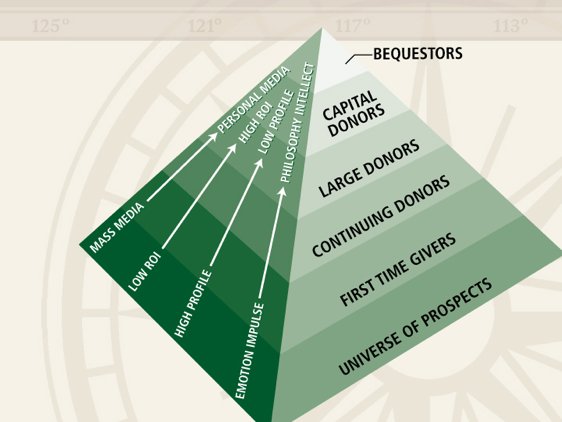You are familiar with the Donor Pyramid. This classic fundraising image, reproduced below, is meant to illustrate how donors enter a non-profit’s fundraising system, and then how they move up to greater involvement and giving.
 Donor acquisition happens when a non-profit “finds” a donor in the universe of prospects and offers a set of benefits and outcomes in exchange for a financial investment.
Donor acquisition happens when a non-profit “finds” a donor in the universe of prospects and offers a set of benefits and outcomes in exchange for a financial investment.
From there, the donor is cultivated for greater involvement and giving.
Often, the functions listed below each operate (sort of) as a department within the development division of a non-profit organization:
- Donor Acquisition: all types of media
- Direct Mail – for cultivation
- Membership programs – pledges, affinity groups, etc.
- Online – for cultivation
- Midlevel program
- Major Gifts
- Planned Giving
- Capital Campaign function (when needed)
I may have left off some “departments,” or you might call them something else. My point is that these functions are often “owned” by someone who cares more about the performance of their silo than the journey of the donor from entry to growth and maturity.
Think about what I just said. The direct mail manager is more concerned about hitting certain performance and ROI targets for direct mail than he is interested in the entire journey of the donor. And this is what the “team” looks like (pardon the hokey graphics):
 All of these clusters of people are good, competent and well-meaning. But they are all separate – doing their own thing to develop net revenue for the organization. I guarantee you that many members of each group above are either ignorant of or don’t really have the time to care about the donor and her journey with the organization. They simply need to hit those targets and all will be well.
All of these clusters of people are good, competent and well-meaning. But they are all separate – doing their own thing to develop net revenue for the organization. I guarantee you that many members of each group above are either ignorant of or don’t really have the time to care about the donor and her journey with the organization. They simply need to hit those targets and all will be well.
This dynamic, present in every non-profit Jeff and I have worked with over the last 30-40 years, is why the donor suffers and we have such a dismal record of donor and value retention in the non-profit world.
If we had a donor-centered view, our organization would be a place where everyone is working together for the common good of the donor – picture a line of department heads all holding hands with a single focus on the donor. They would be linked together as a chain, carefully, and with a caring spirit, passing the donor through the upgrading and retention process – always driven by the donor’s interests and passions.
As Jeff and I have thought about it, the entire fundraising effort – from acquisition all the way up the pyramid to transformational giving – should not be viewed as individual rooms of the fundraising house or even as the classic pyramid, which also conceptualizes the fundraising process as one stacked upon another, but each still separate. Rather, we think the entire process should be viewed as a pipeline: a continuous, fluid flow that nurtures and cares for the journey of the donor.
Think about this as it relates to one of your donors. They find out about your cause and are enticed by your offer to have them join your growing group of supporters. They join by giving their first gift.
But now they are cared for by a group of employees in your organization who regularly talk to each other about how that donor is doing in their journey with the organization. Questions are being asked. What else can we do for her? What more can we say about how her giving is making a difference? What does she care about? How can we serve that caring in a meaningful way? How can we carefully pass her along through the pipeline to greater involvement with us?
This kind of thinking transforms fundraising in two ways:
- It focuses first on a donor and her interests and passions. Yes, this can be done through mass mailings, etc. Technology is now at the point where you can take your organization’s budget and cause and create a Donor Impact Portfolio (DIP) where all of your programs are placed into categories and subcategories – tracks, if you will – that the donor can come into (acquisition) and then journey on through (cultivation and upgrading) in her donor life with you.
- It creates strategies and systems to serve those passions and interests with an economic goal of helping donors give to their fullest capacity. This is why Jeff and I are reframing the fundraising process from how it is current viewed to one that views the entire process as the major gift pipeline, i.e. helping the donor give to their capacity. Right now, we organize by giving level: mass market (the smaller givers), midlevel, major, planned, etc. Note that this is OUR view of donors, not their view of us. Think how powerful it would be if we organized our strategies and systems around our program categories and subcategories – individual interest and passion tracks, if you will, that the donor could run on. It would be powerful. Yes, we would still pay attention to giving levels for all the reasons we do now. But our focus and overall strategy would be different – creating and maintaining those individual program tracks that match donors’ interests and passions.
At its simplest, here is what Jeff and I are talking about:
Create a fundraising system and strategy that helps the donor give to their capacity, i.e. view the entire fundraising effort, from acquisition through the ultimate gift, as helping the donor do what they were meant to do.
We call this the major gift pipeline because its sole focus is to help the donor give to their capacity.
Think about how this would change things for you and for your donors. It would truly transform your fundraising, since it would move the focus from “how do we extract more money from the donor” to “how do we help the donor fully express his passions and interests.”
Jeff and I are convinced that this approach will not only result in more net revenue to your organization, but it will substantially improve donor and value retention.
Richard
Read the whole series on MG Organizational Structure:
- What’s Wrong
- The Right Context
- The Major Gift Pipeline (this post)
- The Four Main Things
- Can’t We All Get Along
- Reengineer to be Donor-Facing






0 Comments
Trackbacks/Pingbacks